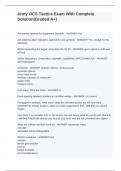HIM 151(PRINCIPLES OF HEALTHCARE
REIMBURSEMENT) 5TH EDITION
QUESTIONS AND CORRECT ANSWERS
What is the name of your state's insurance commission? ✅Bureau of Insurance
What is the mission of your state's insurance commission? ✅to ensure that citizens of
the Commonwealth are provided with access to adequate and reliable insurance
protection; that the insurance companies selling policies are financially sound to support
payment of claims; that he agents selling company policies are qualified and conduct
their business according to statutory and regulatory requirements, as well as acceptable
standards of conduct; and that he insurance policies are of high quality, are
understandable, and are fairly priced.
List three consumer-related topics on the insurance commission's website ✅Shopping
tips for buying health insurance, how to file a complaint, and guides and publications on
life insurance
True? or False? The national health service (Beveridge) model is different from the
social insurance (Bismarck) model because the Beveridge model is financed by general
revenue funds from fiscal taxes, whereas the Bismarck model is financed by worker's
and employers' compulsory payroll contributions into sickness funds. ✅True
What are the four characteristics of the US healthcare sector? ✅its large size,
complexity, intricate payment methods and rules, and broad program scopes
True? or False? The federal role in the healthcare sector is limited to paying providers
for the healthcare costs of senior citizens. ✅False- To make true- The US federal
government is the dominant payer in the healthcare sector. Medicare is a health
insurance program for senior citizens, people who have disabilities, and people who
have ESRD. Medicare also provides significant funds for medical, education, research,
and care of disadvantaged or vulnerable people. Medicaid provides reimbursement for
health services received by low-income persons and families, federal government also
pays for health services for other populations including active duty and retired military
personnel and their families, veterans, Native Americas, and injured and disabled
workers
What do insurers receive in return for assuming the insureds' exposure to risk or loss?
✅Insurers' receive PREMIUMS in return for assuming the insureds' exposure to risk or
loss.
,Insurers pool premium payments for all the insureds in a group, then use actuarial data
to calculate the group's premiums so that: ✅The pool is large enough to pay losses of
the entire group
Where and when did health insurance become established in the United States?
✅Health insurance become established in 1929, when Blue Cross first covered school
teachers in Texas.
What is the term for health insurance that only covers the employee? ✅Individual
(single) coverage
What is the term in healthcare that means compensation or repayment for rendering
healthcare services? ✅Reimbursement
Who is the third party in healthcare situations? ✅1st party-Patient, 2nd party-provider,
THIRD PARTY - PAYER,
All of the following are types of episode-of-care reimbursement except: ✅SELF-
INSURED PLAN
What discounted fee schedule does Medicare use to reimburse physicians? ✅The
RESOURCE-BASED RELATIVE VALUE SCALE (RBRVS) was established in 1992,
and it is discounted for fee schedule that Medicare uses to reimburse physicians.
Name and describe some versions of the global payment method. ✅MEDICARE
PAYMENT SYSTEM FOR HOME HEALTH-various types of home health services are
consolidated into the single payment. These services include all speech therapy,
physical therapy, and occupational therapy; skilled nursing visits, home health aide
visits, medical/social services, and non routine medical supplies
TOTAL EPISODE OF CARE-a single price that covers costs across the continuum of
care, which could include facility costs across the continuum of care, such as hospital,
nursing home, clinical, and outpatient rehabilitation, technical and professional
components of procedures in radiology, pathology, and laboratory, physician
professional fees for anesthesia, surgery, and consultation, home care costs. IT IS THE
MOST COMPREHENSIVE VERSION OF THE GLOBAL PAYMENT SYSTEM
GLOBAL SURGICAL PACKAGE - encompasses an operation, local or topical
anesthesia, a preoperative clinic visit, immediate post operative care, and usual
postoperative followup
SPECIAL-PROCEDURE PACKAGE - all costs associated with a diagnostic or
therapeutic procedures
AMBULATORY VISIT PACKAGE - includes all ambulatory services including physicians
charges, laboratory tests, x-rays, and other ambulatory services associated with one
clinic visit
, PER-EPISODE HOME HEALTH PAYMENT- a less comprehensive global payment rate
in which a single payment covers all home care services and non routine medical
supplies that a patient receives during a 60-day period.
MEDICARE PART A ✅covers inpatient hospital services
MEDICARE PART B ✅a supplemental medical insurance
MEDICARE PART C ✅known as MEDICARE ADVANTAGE
MEDICARE PART D ✅Medicare's drug benefit
How does a Medicare beneficiary benefit by choosing Medicare Part C ✅Insurance for
excluded Part A/B services is included in Medicare Advantage, so services such as
long-term nursing care, dental services, vision services, and hearing aids are covered
and provided at a covered rate for Medicare Advantage (Part C) beneficiaries.
What types of costs do Medigap cover? ✅Medigap policies offer supplemental
insurance covering the cost-shared expenses such as the deductibles and 20 percent of
durable medical equipment costs that patients otherwise pay
How does the ACA affect the market basked used to update Medicare reimbursement
rates? ✅The ACA reduced the market basket in two ways. First, there is a scheduled
reduction and second is the multi factor productivity reduction.
Why is Medicaid coverage not identical in New Jersey, California, and Idaho?
✅Coverage differs among the states because Medicaid allows states to maintain a
unique program adapted to states residents' needs and average incomes. Although
state programs must meet coverage requirements for groups such as recipients of
adoption assistance and foster care, other types of coverage, such as vision and dental
services, are determined by the states' Medicaid agencies.
MATCH EACH TRICARE PROGRAM WITH IT DESCRIPTION ON RIGHT
ADFMs with deductible and 20 percent co pay
ADFMs with deductible and 25 percent cost-share
Managed care for ADSMs
Secondary coverage for Medicare beneficiaries ✅ADFM-active duty family member
ADSM-active duty service member
TRICARE STANDARD NETWORK





